The Big Sleep (1946)
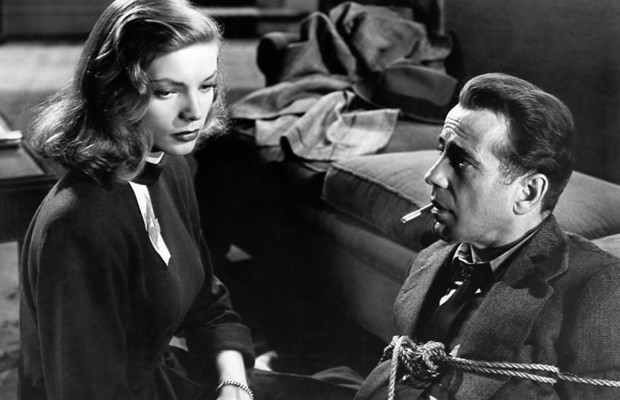
Toronto Film Society presented The Big Sleep (1946) on Monday, August 19, 1968 as part of the Season 20 Summer Series, Programme 5.
The Super Snooper USA 1951(?) 7 mins colour 16mm
A Warner Brothers Looney Tune. Director: Robert McKimson. Story: Tedd Pierce. Voice Characterizations: Mel Blanc.
Animated cartoonists around the world have generally taken themselves and the conventions of their medium a lot less seriously than the commercial-feature-film makers. This was particularly true of the Warner Brothers cartoon unit run by Leon Schlesinger in Hollywood. In addition to inventing and/or consolidating the use of a repertory of conventions unique to the animated cartoon, they often treated themselves and their theatre audiences to a light-hearted examination of current fashions and foibles in feature films. For that matter, so did certain directors of musicals including Busby Berkeley, who had for years headed up a special unit of his own, also at Warners.
But whereas Berkeley (in such memorable musical spoofs as ‘Shanghai Lil’, ‘The Girl at the Ironing Board’, and his preposterous ‘manifesto’-cum-self parody, ‘Dames’) often revealed a rather mellow affection for the very elements being satirized in his numbers, the parodies done by the Warners cartoonists were usually merciless. For quick, clean rapier thrusts the redoubtable ‘Bugs’ Bunny might be put to work. But when they really wanted to take off the gloves, it was Daffy Duck who got the call, as in To Duck or Not to Duck, Confessions of a Nutzy Spy and Yankee Doodle Daffy.)
Tough mystery melodramas were a staple of the ’40’s, and some of them were among the most stylish Hollywood achievements of the decade. However, by the time the Dashiell Hammett phase of the early ’40’s (The Maltese Falcon, The Glass Key, etc.) and the Raymond Chandler phase of the mid-’40’s (Murder, My Sweet; The Big Sleep, The Brasher Doubloon, Lady in the Lake, etc.) had turned leading men from Humphrey Bogart and George Raft to Dick Powell, Franchot Tone, Mark Stevens, Robert Montgomery, and even George Montgomery, into ‘private eyes’, the genre was ripe for the Daffy treatment, and got it in tonight’s cartoon short, The Super Snooper. (S(pr)ay it with Daffy’s slurping enunciation and you’ve got a rough idea of the general tone of reverence for the genre displayed throughout this brief compendium of private-eye cliches.) Few detective thriller conventions are left unscathed in this typical Warners cartoons send-up, which cheerfully takes-off the locales, costumes, dialogue, characters’ attitudes and gestures, plot incidents and even, to some extent, the camera style of the tough who-dun-its of the time.
(Incidentally, although the copyright date on the Looney Tunes opening of this print says ‘1951’, it seems more likely that this Daffy Duck caper was whipped up earlier than that–say around 1947. Possibly the 1951 date is that of a re-release of the film in a new Looney Tunes series. The contrasty and rather gaudy colour in the print we will be seeing indicates that it was never on very close terms with the original negative.
Sensitive viewers may be bothered temporarily by focus-breathing in the early part of this print.)
The Super Snooper, amusing though it is, falls somewhat short of the best Warners cartton parodies, in my own opinion, perhaps because most of its gags have a primarily ‘literary’ bent, and a not-too-subtle one at that. However, subtlety was never Daffy’s stock-in-trade, and if the final effect here is more like that of a buck-shot blast than of a bell-ringing rifle-shot, at least he manages to hit a good number of targets during the shooting.
In any case, any resemblance between The Super Snooper and tonight’s feature film is no accident, on the part of anyone concerned.
Notes by Doug Davidson
The Big Sleep (1946)
Production Company: Warner Brothers. Producer/Director: Howard Hawks. Assistant Director: Chuck Hanen. Script: William Faulkner, Leigh Brackett, Jules Furthman, from the novel by Raymond Chandler. Cinematography: Sidney Hickox. Editor: Christian Nyby. Art Direction: Carl Jules Weyl. Set Decorations: Fred W. MacLean. Special Effects: Roy Davidson, Warren E. Lynch. Music: Max Steiner. Sound: Robert B. Lee.
Cast: Humphrey Bogart (Philip Marlowe), Lauren Bacall (Vivian Sternwood), Martha Vickers (Carmen Sternwood), Dorothy Malone (bookshop girl), Charles Waldren (General Sternwood), Regis Toomey (Bernie Ohls), John Ridgely (Eddie Mars), Louis Jean Heydt (Joe Brody), Elisha Cook, Jr. (Jones), Bob Steele (Canino), Theodore von Eltz (Geiger), Sonia Darren (Agnes), Peggy Knudsen (Mona Mars), Charles D. Brown (Norris), Tom Rafferty (Carol Lundgren).
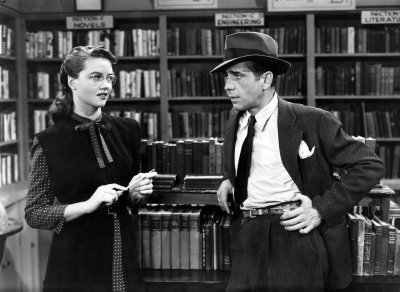
The Big Sleep may be viewed as a study in terror–an incisive look at the horrific nature of fear itself. One of the most blackly drawn depictions of man to emerge from Hollywood, this Howard Hawks film dissects the components of an insidiously terrifying and savage nightmare world. A horror is described that is claustrophobic and threatening yet fearfully unfathomable, a frightful experience where the only recognizable elements are cruelty, shabbiness, and uncompromising evil. Throughout, death and mystery saturate every corner of a chaotic environment, while perversion, greed and hate lurk in the shadows. The film exudes a permanent impression of darkly ominous, rain-soaked streets, of malevolent-looking automobiles sleek with water reflections, and of all sorts of lamps helplessly warring with the powers of darkness. The greenhouse scene provides an introduction to terror, with its typical sultry and secret atmosphere–the sweat that clogs Bogart’s shirt like a stench of death and the lifeless surrounding air evocative of unsavoury growing plants merely preview the pervasive aura of death that clouds the rest of the film. The scene shares with others a sweltering oppressiveness and it is similarly governed by a reflexive violence that thrives and multiplies.
Violence is the principal representative of disorder within the film and the force with which the characters must contend in order to survive. Coiled like an army of secret snakes, nervous, impulsive, profoundly sick, and convincingly real, violence dominates The Big Sleep. Often moving in unpredictable ways, its actions are incomprehensible to those involved with or affected by it. Moving casually, even mechanically, like a well-tooled machine, it is convenient, facile, streamlined and uncompromising in its destructive force. Frequently it serves as the sole introduction to a character or characters (at least two people in the film are known solely as corpses–they are murdered before either detective or audience have met them). Violence is the element in the film that suggests a terror beyond man’s control, a vision from hell.
All the violent events of The Big Sleep are centred around the actions of its hero, Philip Marlowe, who is an amalgam of Howard Hawks-Ernest Hemingway-Raymond Chandler attitudes toward heroes. He is the embodiment of the complete man, a hero dependent upon no one but himself in his battle to subdue the forces of darkness that surround him. An honourable man, he is a champion of justice endowed with a determination to master or two understand his environment. But rigidly adhering to self-prescribed codes of heroic conduct, he exemplifies man’s innate need for self-respect. Not unexpectedly, he is an unattached and essentially lonely individual moving with dignity through an equally lonely world. He is not a young man but is phenomenally agile and alert. To some extent he is lacking in enthusiasm for his role–a cynic perhaps, wise in the ways of the world, who has been pushed around once too often. Typically he sides with the underdog while displaying a thinly veiled contempt for the rich and persons in positions of authority. Interestingly, Marlowe remains relatively indifferent to the violence about him until it reaches a degree that appears to arouse his awareness of remembered wrongs. Thus when Jones is brutally poisoned, Marlowe the cynic-shamus quickly disappears to be replaced by Marlowe the super-avenger. As an avenger, however, he has few ideals and fewer illusions. Grimly pursuing his task, he is laughing all the while, an existential anti-hero convulsed at the absurdity of the world.
Marlowe’s sarcastic attitude is echoed in the general tone of the film. It is alternately malevolent and very funny. And the humour is characterized by the same frantic excitement that is inherent in the film’s perversity and violence. it is both a typically American humour (Mark Twain, Bierce, etc.) and typically Hawksian in its outrageous irreverence, managing to indict everything from the utterly stupid Hayes Code to middle-class audience attitudes toward realism and taste. The humour is the gallows sort that is so evident in His Girl Friday, where truth is never sacrificed to so-called standards of what is proper. Amorality is presented as it is typically in Hawks films–with an utter lack of sentimentality but with generous doses of wit and excitement that accentuate a profoundly real quality of evil. #
This sardonic outlook of The Big Sleep is typically rendered in the episodic manner common to Hawks films. Narrative order struggles to gain a foothold on chaos, but ultimately neither a real beginning, nor middle, nor end is discernible in the story. The Big Sleep is structured like a circle; one remembers images rather than a plot. The skeletal plot, if one may call it that, exists merely as a base for some highly diverting scenes. Succeeding or failing by themselves, these scenes radiate their own individual entertainments and are lit or shrouded with their own aspects of evil and dark humour. Even they become lost as entities, however, amongst the relentless rain and gloom that conjoin in extinguishing continuity and narrative conclusiveness. A sole structural element, an undercurrent of excitement, underlies the total rambling length of the film–although approximately two hours long, The Big Sleep never drags.
Notes by Robert McMillan
# An exception to this, of course, is Sergeant York, which is, in my opinion, neither typical of Hawks’ work nor one of his best films.
_____________________________________________________________
OMITTED from the credits for To Have and Have Not: Dolores Moran played the part of Madame de Brusac, the wife of the wounded man in the cellar.

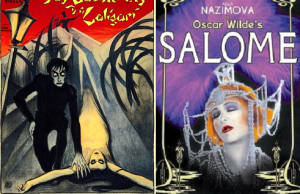
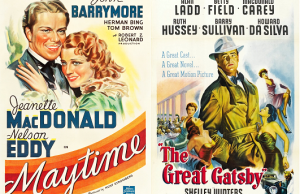
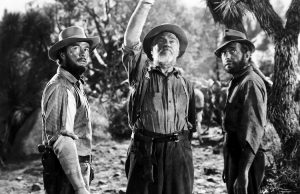






Leave a Reply